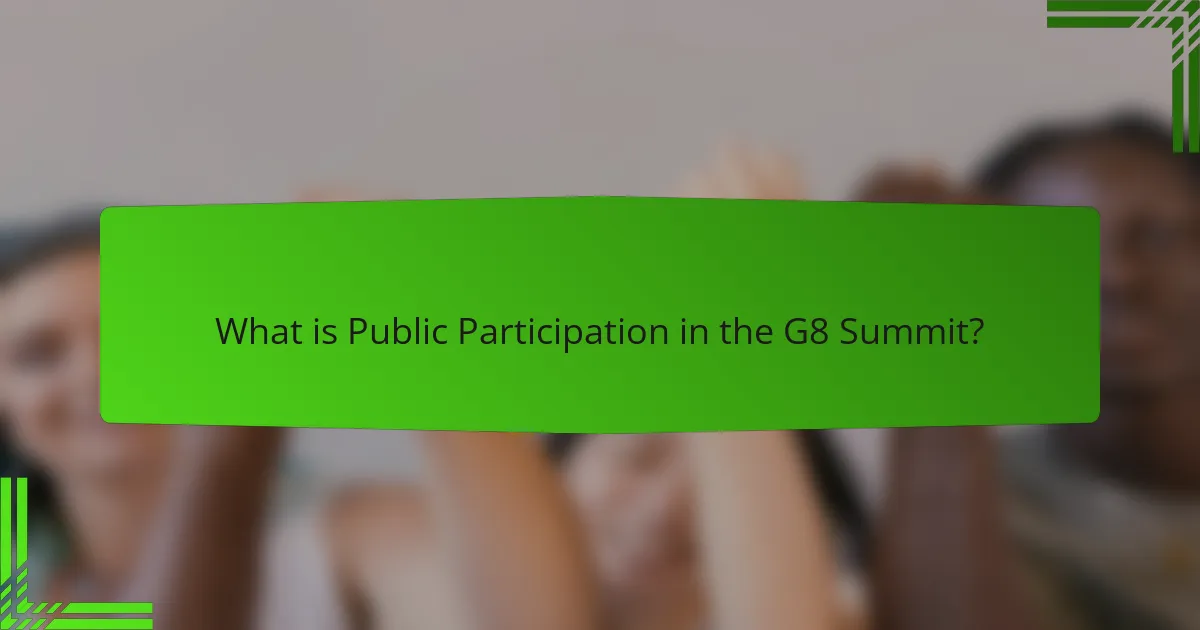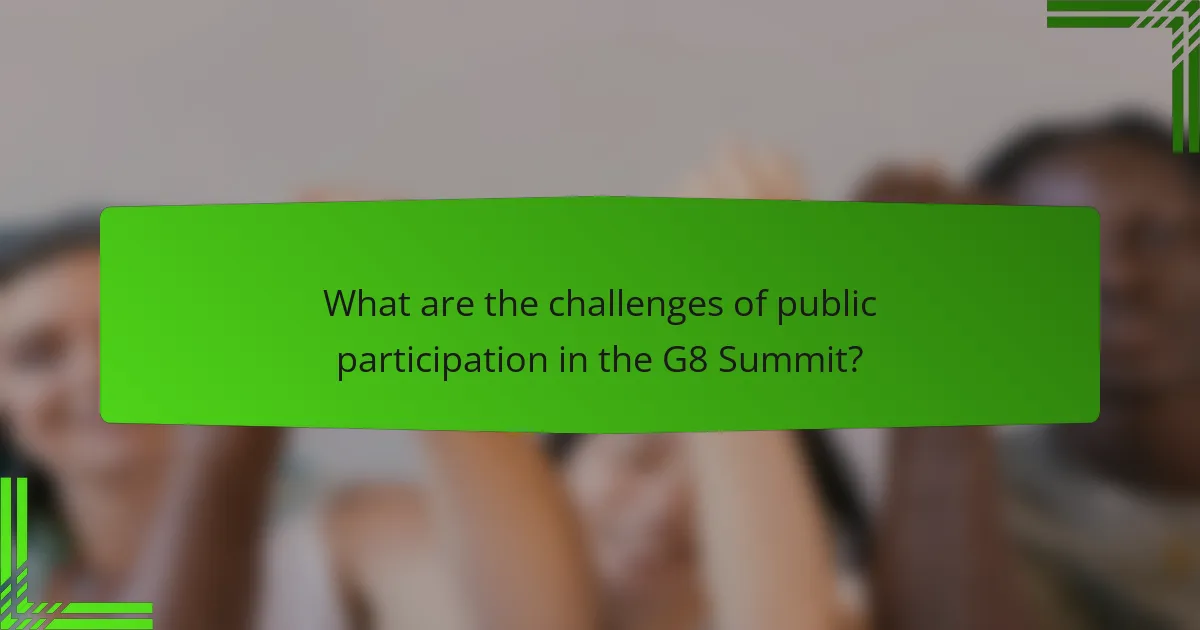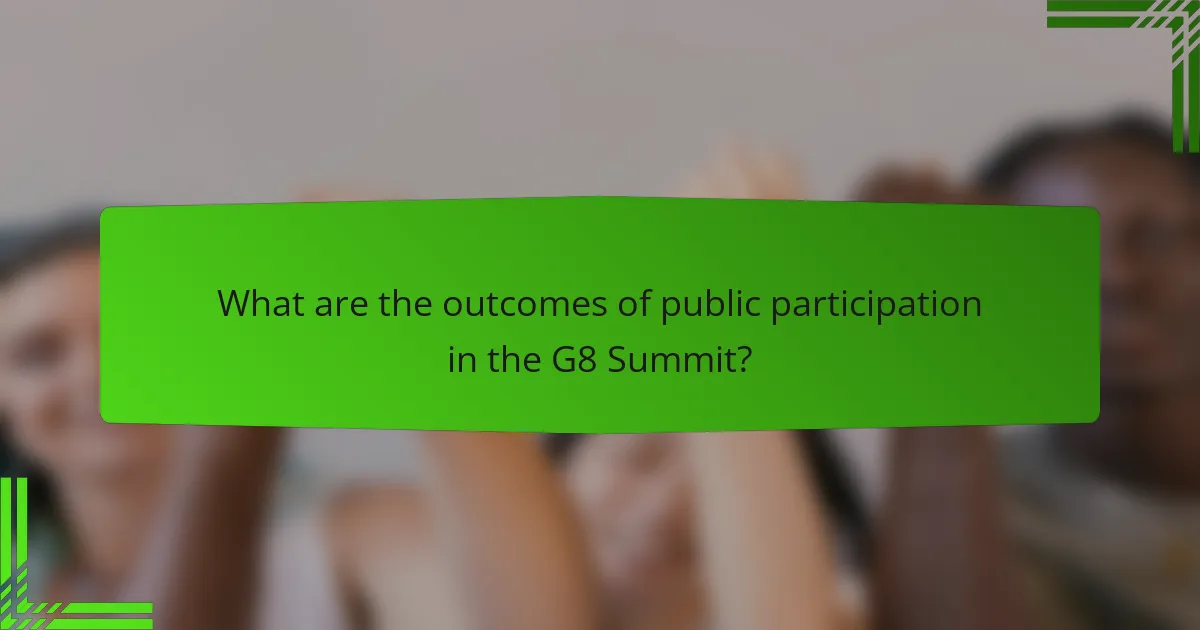Public participation in the G8 Summit encompasses the active involvement of citizens and civil society organizations in the summit’s discussions and decision-making processes. This participation is essential for fostering transparency and accountability in global governance, allowing diverse voices to impact policies related to critical issues such as poverty, climate change, and security. Despite its importance, public participation faces challenges, including limited access to decision-making, exclusion of grassroots perspectives, bureaucratic obstacles, and security concerns. Historical examples illustrate the effectiveness of civil society engagement in shaping summit agendas and outcomes, while ongoing participation enhances awareness and advocacy for global issues, ultimately holding G8 leaders accountable to their constituents.

What is Public Participation in the G8 Summit?
Public participation in the G8 Summit refers to the involvement of citizens and civil society organizations in the discussions and decision-making processes of the summit. This participation is crucial for promoting transparency and accountability in global governance. It allows diverse voices to influence policies that impact international issues like poverty, climate change, and security. Historically, public participation has been facilitated through forums, protests, and dialogues alongside the official summit meetings. For example, during the 2005 G8 Summit in Gleneagles, Scotland, extensive public engagement was organized to address issues like debt relief and climate change. This engagement demonstrated the effectiveness of civil society in shaping the agenda and outcomes of the summit.
How does public participation manifest during the G8 Summit?
Public participation during the G8 Summit manifests through various forms of activism and civil society engagement. Activists organize protests and demonstrations to voice concerns on global issues. Civil society organizations hold forums and discussions to influence policy decisions. Public consultations allow citizens to express their views on summit topics. Media coverage amplifies public discourse and raises awareness. Online campaigns mobilize global audiences to engage with summit agendas. Grassroots movements advocate for marginalized communities and highlight their needs. These activities collectively shape the dialogue around the G8’s priorities and decisions.
What forms of activism are commonly seen at the G8 Summit?
Common forms of activism at the G8 Summit include protests, advocacy campaigns, and public demonstrations. Activists often organize large-scale rallies to express dissent against G8 policies. These protests typically focus on issues such as poverty, climate change, and global inequality. Advocacy groups use the summit as a platform to lobby for policy changes. Civil society organizations often present alternative proposals to the G8 agenda. Public demonstrations aim to raise awareness and mobilize public opinion. Additionally, art and cultural expressions are used to convey messages of resistance. The presence of counter-summits is also a notable form of activism, providing a space for alternative dialogue.
How do civil society organizations engage with the G8 process?
Civil society organizations engage with the G8 process through advocacy, dialogue, and participation in forums. They influence policy discussions by presenting research and recommendations. These organizations often conduct campaigns to raise awareness on key issues. They also mobilize public opinion to pressure G8 leaders. Civil society representatives attend G8 meetings to voice concerns. They participate in side events and parallel summits. This engagement aims to hold G8 leaders accountable. Historical examples include the G8 Summits where NGOs highlighted poverty and climate change.
Why is public participation important for the G8 Summit?
Public participation is important for the G8 Summit because it fosters transparency and accountability. Engaging the public allows for diverse perspectives to be considered in decision-making. This inclusivity can lead to more effective policies that reflect the needs of the global community. Historical instances show that public input can influence G8 outcomes. For example, civil society organizations have successfully advocated for issues like climate change and poverty reduction. Their involvement ensures that marginalized voices are heard. Ultimately, public participation strengthens democratic processes at the international level.
What impact does public participation have on G8 decision-making?
Public participation significantly influences G8 decision-making. It enhances transparency and accountability in the process. Engaging civil society leads to more inclusive policies. Public input can shape the agenda and priorities of the G8. Historical examples show that protests and advocacy have resulted in tangible policy changes. For instance, the 2005 G8 Summit in Gleneagles was heavily influenced by public campaigns on poverty and climate change. This engagement often pressures leaders to address pressing global issues. Ultimately, public participation fosters a more democratic approach to international governance.
How does public engagement influence global policies discussed at the G8?
Public engagement significantly influences global policies discussed at the G8. It shapes the priorities and agendas of the summit. Civil society organizations advocate for specific issues, such as climate change and poverty reduction. Their activism can lead to increased attention from G8 leaders. Public opinion also pressures governments to adopt more progressive policies. For instance, the Make Poverty History campaign in 2005 mobilized millions, impacting G8 discussions on aid and debt relief. Engagement through social media amplifies these voices, making it harder for leaders to ignore public sentiment. Ultimately, public engagement fosters accountability and responsiveness in global governance.

What are the challenges of public participation in the G8 Summit?
Public participation in the G8 Summit faces several challenges. Limited access to decision-making processes restricts engagement. The high-level nature of G8 discussions often excludes grassroots voices. Bureaucratic hurdles can hinder effective participation from civil society organizations. Security concerns during summits can restrict public demonstrations and interactions. Additionally, lack of transparency in agenda-setting can lead to distrust among stakeholders. These factors collectively diminish the potential for meaningful public involvement in G8 deliberations.
What barriers do activists face when trying to participate?
Activists face several barriers when trying to participate in events like the G8 Summit. One significant barrier is access to information. Many activists struggle to obtain timely and relevant details about the event. This lack of information can hinder their ability to prepare adequately. Another barrier is funding. Activists often have limited financial resources to support travel and accommodation expenses. Legal restrictions also pose challenges. Some activists encounter laws that limit their right to assemble or protest. Additionally, security measures can create obstacles. Increased police presence may intimidate activists and deter participation. Lastly, societal stigma can affect activists. They may face backlash or negative perceptions from the public or authorities. These barriers collectively impact the effectiveness and engagement of activists.
How do governmental and institutional responses affect participation?
Governmental and institutional responses significantly influence participation in public events like the G8 Summit. These responses can either encourage or discourage civic engagement. For example, supportive policies can enhance accessibility and inclusivity. Conversely, restrictive measures can limit participation and create barriers. Research shows that when governments actively engage with civil society, participation rates increase. A study by the International Institute for Democracy and Electoral Assistance found that transparent communication fosters greater public involvement. Additionally, funding for civil society initiatives can boost participation levels. Thus, the nature of governmental and institutional responses plays a crucial role in shaping public engagement.
What role does media play in shaping public perception of participation?
Media significantly influences public perception of participation. It serves as a primary source of information about events and issues. Coverage can highlight the importance of civic engagement. Positive portrayals can encourage more individuals to participate. Conversely, negative framing may discourage involvement. Research shows that media representation shapes societal attitudes toward activism. A study by McLeod and Hertog (1999) found that media narratives impact public understanding of social movements. Thus, media plays a crucial role in shaping how participation is perceived and acted upon.
How can civil society enhance their engagement in the G8 Summit?
Civil society can enhance their engagement in the G8 Summit by actively participating in dialogues and discussions. They should organize forums to voice their concerns and priorities. Collaboration with governments and other stakeholders is essential for effective influence. Utilizing social media platforms can amplify their messages and reach a broader audience. Civil society organizations can conduct research to provide data-driven insights on key issues. They can also mobilize grassroots movements to demonstrate public support for specific agendas. Engaging in advocacy campaigns can pressure leaders to consider civil society perspectives. Building coalitions with other organizations can strengthen their collective impact on summit outcomes.
What strategies can activists employ to increase visibility at the summit?
Activists can employ various strategies to increase visibility at the summit. They can organize peaceful protests to draw attention to their causes. Engaging in social media campaigns can amplify their messages to a broader audience. Collaborating with influential speakers can lend credibility and attract media coverage. Activists may also create eye-catching visuals or art installations that resonate with attendees. Utilizing press releases to inform journalists about their activities can enhance visibility. Networking with other organizations can strengthen their presence and collective impact. Hosting workshops or discussion panels can provide platforms for dialogue and engagement. Lastly, distributing informative materials can educate attendees about their issues.
How can collaboration among organizations strengthen public participation?
Collaboration among organizations can strengthen public participation by pooling resources and expertise. When multiple organizations work together, they create a broader platform for engagement. This collaboration enhances visibility and outreach to diverse populations. It also fosters trust among stakeholders, encouraging more individuals to participate. Joint initiatives can lead to more comprehensive and inclusive decision-making processes. For example, the G8 Summit saw various civil society organizations collaborating to amplify their voices. This resulted in increased attendance and input from the public. Studies show that collaborative efforts can lead to higher levels of civic engagement and satisfaction.

What are the outcomes of public participation in the G8 Summit?
Public participation in the G8 Summit leads to increased awareness and advocacy for global issues. It fosters dialogue between civil society and political leaders. This engagement often results in policy recommendations that reflect public concerns. Historical examples include the 2001 G8 Summit in Genoa, where protests highlighted social justice issues. Outcomes also include the establishment of forums for ongoing civil society interaction. Reports indicate that public participation can influence the agenda of future summits. Furthermore, it enhances accountability among G8 leaders to their constituents. Overall, public participation shapes the narrative around global governance and development.
What successes have been achieved through activism at the G8?
Activism at the G8 has led to significant successes in various areas. One notable achievement is the commitment to debt relief for impoverished nations. Activist pressure contributed to the G8’s agreement to cancel approximately $40 billion in debt for 18 countries in 2005. Additionally, activism has raised awareness about global health issues, influencing the G8 to pledge $60 billion to combat AIDS, tuberculosis, and malaria in 2005. Another success is the promotion of climate change initiatives. Activists have pushed for commitments to reduce greenhouse gas emissions, leading to discussions on sustainable development. The G8 has also been influenced to support fair trade practices, improving conditions for farmers in developing countries. These successes demonstrate the impact of civil society engagement at the G8 summits.
How have past G8 Summits responded to civil society demands?
Past G8 Summits have responded to civil society demands through various initiatives and commitments. For instance, in 2005, the Gleneagles Summit focused on African development and debt relief, influenced by civil society campaigns. The leaders pledged to increase aid and address climate change, partly due to pressure from activists. Additionally, the 2009 L’Aquila Summit saw commitments to food security, responding to demands from organizations like Oxfam. In 2013, the G8 leaders addressed tax evasion and transparency, reflecting civil society’s push for corporate accountability. These responses were often shaped by extensive lobbying and advocacy efforts from non-governmental organizations.
What lessons can be learned from previous public engagement efforts?
Previous public engagement efforts demonstrate the importance of inclusivity and transparency. Engaging diverse stakeholders fosters broader perspectives and richer dialogue. Successful initiatives often utilized clear communication strategies to convey objectives. Effective feedback mechanisms allowed for continuous improvement and adaptation. Historical examples, such as the 2002 World Summit on Sustainable Development, highlighted the value of multi-stakeholder partnerships. These partnerships enhanced credibility and trust among participants. Additionally, timely and accessible information proved crucial in mobilizing public interest. Overall, learning from past initiatives emphasizes the need for strategic planning and community involvement.
What best practices can be adopted for future participation?
Best practices for future participation in public events like the G8 Summit include early engagement, clear communication, and inclusive strategies. Early engagement allows stakeholders to voice concerns and contribute to agenda-setting. Clear communication ensures that all participants understand the objectives and processes involved. Inclusive strategies promote diverse representation, ensuring marginalized voices are heard. Utilizing technology can enhance participation through virtual platforms, reaching wider audiences. Regular feedback mechanisms help organizers adjust strategies based on participant experiences. Research shows that these practices lead to more effective and meaningful engagement in public forums.
How can activists effectively prepare for the G8 Summit?
Activists can effectively prepare for the G8 Summit by organizing their strategies in advance. They should identify key issues that will be discussed at the summit. Understanding the agenda allows activists to tailor their messages accordingly. Building coalitions with other organizations strengthens their influence. Activists should also plan for logistics, including travel and accommodation. Engaging in grassroots mobilization increases public awareness and participation. Training volunteers on messaging and protest strategies enhances effectiveness. Monitoring the summit’s developments in real-time aids in timely responses. These preparation steps have been proven effective in previous summits, where organized activism influenced discussions.
What tools are available for enhancing civil society engagement?
Digital platforms are essential tools for enhancing civil society engagement. These platforms facilitate communication and collaboration among various stakeholders. Social media channels allow for real-time interaction and mobilization. Online petitions enable citizens to express their opinions and influence decision-making. Webinars and virtual forums provide educational resources and discussion spaces. Data visualization tools help present complex information clearly. Collaborative software supports joint initiatives and project management. Crowdfunding platforms enable financial support for civil society projects. These tools collectively empower communities and enhance their participation in public discourse.
Public participation in the G8 Summit encompasses the active involvement of citizens and civil society organizations in shaping discussions and decision-making processes. This engagement is vital for ensuring transparency and accountability in global governance, influencing policies on critical issues such as poverty and climate change. The article examines the various forms of activism, the role of civil society organizations, and the impact of public participation on G8 decision-making, while also addressing the challenges and barriers faced by activists. Furthermore, it highlights successful outcomes from past summits and outlines best practices for enhancing future engagement.